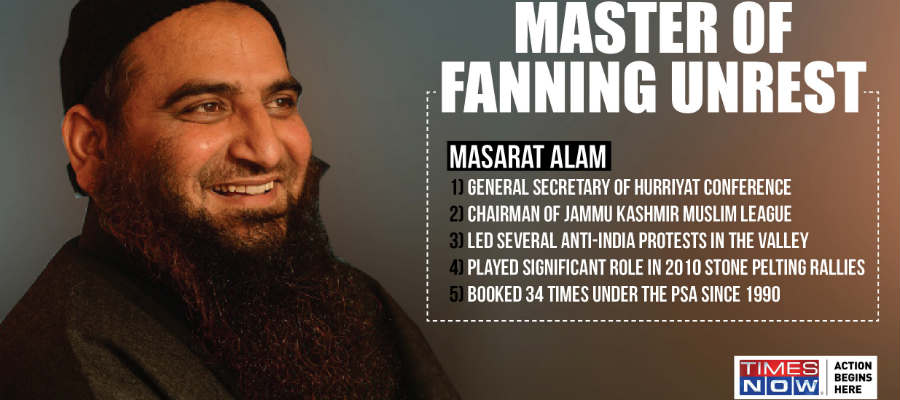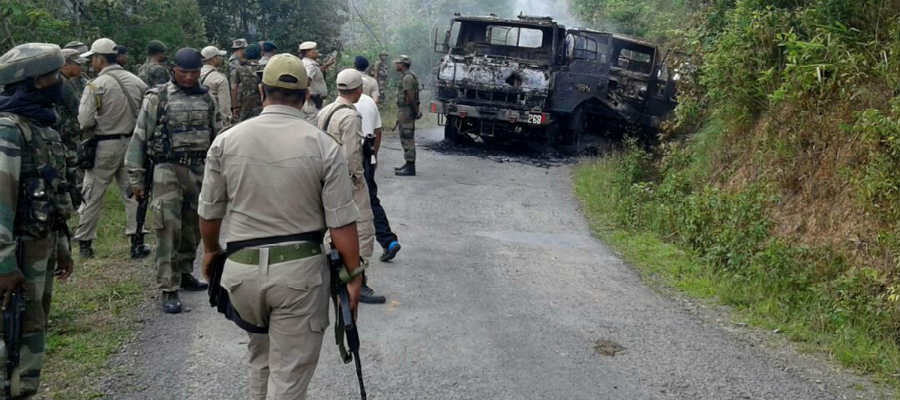BY RSN SINGH
The hide and seek judicial affair with respect to Masarat Alam in his long career of militancy is a sad commentary on the will and preparedness of the state of J&K to fight Pakistan’s proxy war. This kind of asymmetric war can only persist with proxies within India like Masarat Alam. Such Pakistani proxies abound not only in J&K but in many other parts of India.
There is no gain advocating, an Osama type operation on Hafiz Saeed or Mullah Mansoor Azhar, if the state is seen weak in handling the proxies within the country. The institutional weakness in dealing with these proxies is because the Pakistan’s ISI has subverted every organ of the state.
The perverseness of subversion was very much in evidence when Yakub Memon was counting minutes before his hanging. More than 15 agencies were hired to leverage various organs of the state. The midnight drama that resulted from this leveraging has left an indelible blot on the seriousness of the Indian State in fighting Pak sponsored proxy war. It also gives credence to insinuations about the involvement of people in Lutyens’ Delhi in promoting different brands of terror for political ends. One such promotion allegedly was by way of 26/11, nevertheless this project of creating ‘Hindu Terror’ was destroyed by the apprehension of Ajmal Kasab.
The moot question is: what is the difference between likes of Ajmal Kasab and Masarat Alam? Both are jihadis, both are indoctrinated in the same jihadi philosophy, both are connected to the global jihadi network, both are engaged in the destruction of India, and both are guided by the same leadership ensconced in Pakistan.
Masarat Alam supported the 2008 Mumbai attacks. Soon after he raised slogans in Srinagar, “Hafiz Saeed ka kya paigam, Kashmir Banega Pakistan” (What is the message from Hafiz Saeed, that Kashmir will become Pakistan). In April 2015, Masarat Alam unfurled Pakistan flag in Srinagar and chanted pro-Pak slogans to greet his mentor Geelani. During the same period, Hafiz Saeed held a rally in Lahore in support of Masarat Alam.
Why therefore persist with the word ‘separatist’ in respect of militants of Masarat Alam’s ilk, when it is actually a euphemism for pro-Pakistan. Just as Hafiz Saeed is India’s enemy so should be Masarat Alams and Geelanis. Both Geelani and Masarat Alam forfeited their moral claims to constitutional rights long ago when they decided to wage war against India.
Masarat Alam actually symbolizes militancy in Kashmir. The beginning of his militant career coincides with the onset of jihad in the Valley, post 1989. This was the year when the military-intelligence establishment of Pakistan embarked on jihadi war in Kashmir after conclusion of Islamic war against the Soviet forces in Afghanistan. It cost Pakistan nothing, as the ISI was flush with funds and weapons provided by USA and Saudi Arabia. There were nearly 300 jihadi groups to begin with, who were indoctrinated, trained and equipped at Ojhri camp located 10 km from Islamabad. This 80-acre facility was the training and logistic base for all Pakistani and international jihadi groups. Post 1989, the jihadi orientation of these groups towards India heralded militancy in the Valley. Therefore there is nothing indigenous about the Kashmir militancy. It has a geopolitical context rather than any internal facets.
Heini G. Kiessling in his book ‘The ISI of Pakistan’ says:
“From 1988, the ISI began to organize training camps for young militants from the Valley. At the beginning their partner was the Jammu Kashmir Liberation Front (JKLF), who were responsible for recruiting the fighters, while the ISI delivered training and equipment. Funding came from the Gulf region and the drug trade, and donations were collected in the mosques of Pakistan, US and Western Europe. All this ensured the requirement and training of new young volunteers and the deployment of battle-hardened mujahideen from Afghanistan. The recruits came mainly from Punjab and NWFP, but young Muslims were also enlisted from abroad. The training camps for the volunteers from Jammu and Kashmir were located in Azad Kashmir (POK), close to the LoC; the camps for the Pakistanis and the foreigners were in Punjab and NWFP.”
Further about Lashkar-e-Taiba (LeT) and Jaish-e-Mohammad (JeM), Kiessling says that both organizations grew rapidly and were extremely successful in recruitment and suicide assassinations. The JeM, he says, also had links to Al Qaeda.
The LeT is also known to have strong links with the Al Qaeda, as consequent to Operation Enduring Freedom by the US and the allies, many of the Al Qaeda cadres joined the LeT.
A majority of the attacks in the Valley has been perpetrated by these two organizations. It is the global jihad therefore which has been impacting J&K.
Masarat Alam or Geelani are Pakistani agents engaged in the business of global jihad. Hence, any concessions to them amounts to providing impetus to this world wide menace. Masarat Alam was arrested in April 2015 under the Public Security Act of J&K. The Act itself, as far as militancy is concerned, is a misnomer because it is not just the public security that militants are vitiating but their terrorism has impact on jihadi discourse not only in the Valley but entire India. Most jihadi terrorist attacks in India have their umbilical to Kashmir, which includes 26/11.
It is criminal for the Indian State that an incorrigible militant like Masarat Alam, who has undergone nine detentions since 1989 and carried a bounty of Rs.15 lacs, should endemically be given benefit of doubt as though he was an ordinary criminal. Masarat Alam, it may be reiterated, not only heralded jihadi militancy in Kashmir but is also the progenitor of the stone pelting industry in the Valley, which he assiduously assembled in 2010. He is the one who programmed and calibrated ‘war of stones’ in the Valley. Arguably, the stone-pelting industry has taken a big hit by demonetization.
A very important question then arises, as to why the Valley, which constitutes just about eight percent of the total area of J&K, should be allowed to destabilize the entire country. Professor Hari Om, a resident of the Jammu region, in his book ‘Beyond the Kashmir Valley’ emphasizes that the highest per capita consumption of meat in the world is in the Kashmir Valley, not one Kashmiri has died of hunger and cold, and there is no Kashmiri without roof. As per NDTV report ‘Kashmir eats 51,000 tons of mutton a year’ dated 27 July 2011: “About 85 per cent of Kashmiris eat non-vegetarian fare – but exactly how much? Official statistics say Jammu and Kashmir annually consumes a whopping 51,000 tonnes of mutton worth Rs.12.06 billion (over Rs.1,200 crore), of which 21,000 tonnes is imported from outside. “The 21,000 tonnes is in addition to 30,000 tonnes of mutton produced locally and costing Rs.7.02 billion (Rs.702 crore) which also goes into the local consumption each year,” a senior official of the animal husbandry department here told IANS.”
It can thus be averred that jihadi militancy in Kashmir is mainly spurred by a thriving local economy subsidized by India and the Gulf countries, mainly Saudi Arabia. The Saudi brand of Islam, i.e. Wahhabism, has spread in the Valley purely on the strength of money. It is this brand of Islam that has proliferated and is providing a rich-harvest of jihadis. A video by one Maulana Mushtaq Veeri has been viral in the Valley. It dwells on Salafi mission in Kashmir and emphatically proclaims that it will soon establish a Salafi dispensation in the State. Salafi mosques have proliferated in the Valley, and infuse youth with perverted version of world events.
The jihadis militancy in the Valley must be viewed from the prism of geopolitics, i.e. the global jihadi discourse, territorial ambition of Pakistan, and strategic imperatives of powers like China. The China-Pakistan Economic Corridor (CPEC) has imparted a new Chinese strategic imperative to the region of J&K. Gilgit-Baltistan, which India considers as an occupied territory, is critical for CPEC. The waving of Chinese flags in Srinagar after Friday prayers is therefore not incidental. Masarat Alams, Geelanis, Masood Azhars and Hafiz Saeeds are solidly behind China for various reasons as far as the CPEC goes. Towards this, they are seen to be abandoning all pretentions of jihad. Somewhere they have realized that jihad cannot survive without Pakistan and Pakistan without China. Possibly, inthe assessment of Chinese leadership, jihadi leaders like Masood Azhar are strategically indispensable, hence they need to be bailed out at the UN.
Also, not the least incidental is the waiving of flags the Islamic State in the Valley after Friday prayers. There is another jihadi discourse brewing in Afghanistan, wherein the American jihadis (Islamic State) are pitted against the Russian jihadis (Afghan-Taliban). Recently on 27 December 2016, representatives of Russia, China and Pakistan met in Moscow, wherein it was decided that the Afghan-Taliban should be accommodated in the peace process in Afghanistan. This geopolitical alignment, much to the chagrin of Afghanistan is likely to include Iran as well. This major Russian strategic shift reportedly has been engendered by the relocation of the Islamic State in Afghanistan at the behest of the US. The threat perception of Moscow with regard to the Islamic State in Afghanistan has exacerbated in the recent times. It reckons a direct threat to its interests in Central Asia and Russian territory itself, as Russians form the largest group of Islamic State fighters.
This strategic alignment poses a formidable geopolitical predicament for India in this game of US-jihadis versus Russian-jihadis. For India it amounts to a boost in Pakistan’s concept of ‘Good Taliban and Bad Taliban’. This emerging jihadi discourse not only deeply hurts Indian interests in Afghanistan, where it has sunk lot of goodwill and money, but it also will impact on Kashmir. In the Moscow meeting, Russia and China issued a categorical statement regarding their advocacy of delisting jihadi terrorists of Afghanistan from the UN Sanctions list. This is what ‘global war against terror’ has been reduced to! An emboldened Pakistan with new strategic benefactors like Russia and China may explore new lengths of jihadi proxy war in Kashmir.
The rude message to India is that it has to fight global jihad on its own, and other powers will align and realign in this war depending on their respective strategic interests which are anything but permanent.
The manner in which India deals with Masarat Alam will determine the trajectory of the Indian component of jihadi proxy war. The first step in this direction would be to discontinue the usage of words ‘separatists’ and ‘separatism’. Recently, the Supreme Court of India emphasized: “J&K has no vestige of sovereignty outside the Indian Constitution… citizens of state are first and foremost citizens of India.” This emphatic statement of the Supreme Court needs to be implemented in letter and spirit. When implemented with fidelity to India, it will automatically render likes of Masarat Alam, enemies of the State.
Those in the Valley seduced by Pakistan must know that in a recent survey in the US, 22 percent Pakistanis and 40 percent Bangladeshis mentioned their country as ‘India’. They have found no fruits from two decades of global jihad, rather they are abashed about it. The pro-Pak Kashmiris will ultimately realize their religious folly, but not before wasting a generation or two. The salvation of these anti-India elements lies in reclaiming the depth of their civilization, i.e Kashmiriyat rather than jihad and Ummah, two most fallacious, seductive and destructive concepts.
(RSN Singh is a former military intelligence officer who later served in the Research & Analysis Wing. The author of two books: Asian Strategic and Military Perspective and Military Factor in Pakistan, he is also a Guest Blogger with Canary Trap. The opinions expressed by the author and those providing comments are theirs alone, and do not reflect the opinions of Canary Trap or any employee thereof)

